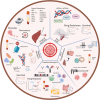Biomarkers for diagnosis and therapeutic options in hepatocellular carcinoma
- PMID: 39242496
- PMCID: PMC11378508
- DOI: 10.1186/s12943-024-02101-z
Biomarkers for diagnosis and therapeutic options in hepatocellular carcinoma
Abstract
Liver cancer is a global health challenge, causing a significant social-economic burden. Hepatocellular carcinoma (HCC) is the predominant type of primary liver cancer, which is highly heterogeneous in terms of molecular and cellular signatures. Early-stage or small tumors are typically treated with surgery or ablation. Currently, chemotherapies and immunotherapies are the best treatments for unresectable tumors or advanced HCC. However, drug response and acquired resistance are not predictable with the existing systematic guidelines regarding mutation patterns and molecular biomarkers, resulting in sub-optimal treatment outcomes for many patients with atypical molecular profiles. With advanced technological platforms, valuable information such as tumor genetic alterations, epigenetic data, and tumor microenvironments can be obtained from liquid biopsy. The inter- and intra-tumoral heterogeneity of HCC are illustrated, and these collective data provide solid evidence in the decision-making process of treatment regimens. This article reviews the current understanding of HCC detection methods and aims to update the development of HCC surveillance using liquid biopsy. Recent critical findings on the molecular basis, epigenetic profiles, circulating tumor cells, circulating DNAs, and omics studies are elaborated for HCC diagnosis. Besides, biomarkers related to the choice of therapeutic options are discussed. Some notable recent clinical trials working on targeted therapies are also highlighted. Insights are provided to translate the knowledge into potential biomarkers for detection and diagnosis, prognosis, treatment response, and drug resistance indicators in clinical practice.
Keywords: Artificial intelligence; Biomarkers; Cancer diagnosis; Cancer surveillance; Cancer treatment; Cell-free DNA; Circulating tumor DNA; Circulating tumor cells; Clinical trials; HAIC; Hepatocellular carcinoma; Immunotherapies; Liquid biopsy; Liver transplantation; Local ablation; Metabolomics; Methylation; Non-coding RNAs; Serological biomarkers; Surgical resection; TACE; Targeted therapies; Therapeutic option; Tissue biopsy; Tumor-derived vesicles.
© 2024. The Author(s).
Conflict of interest statement
The authors declare no competing interests.
Figures


References
Publication types
MeSH terms
Substances
Grants and funding
LinkOut - more resources
Full Text Sources
Medical
Miscellaneous

